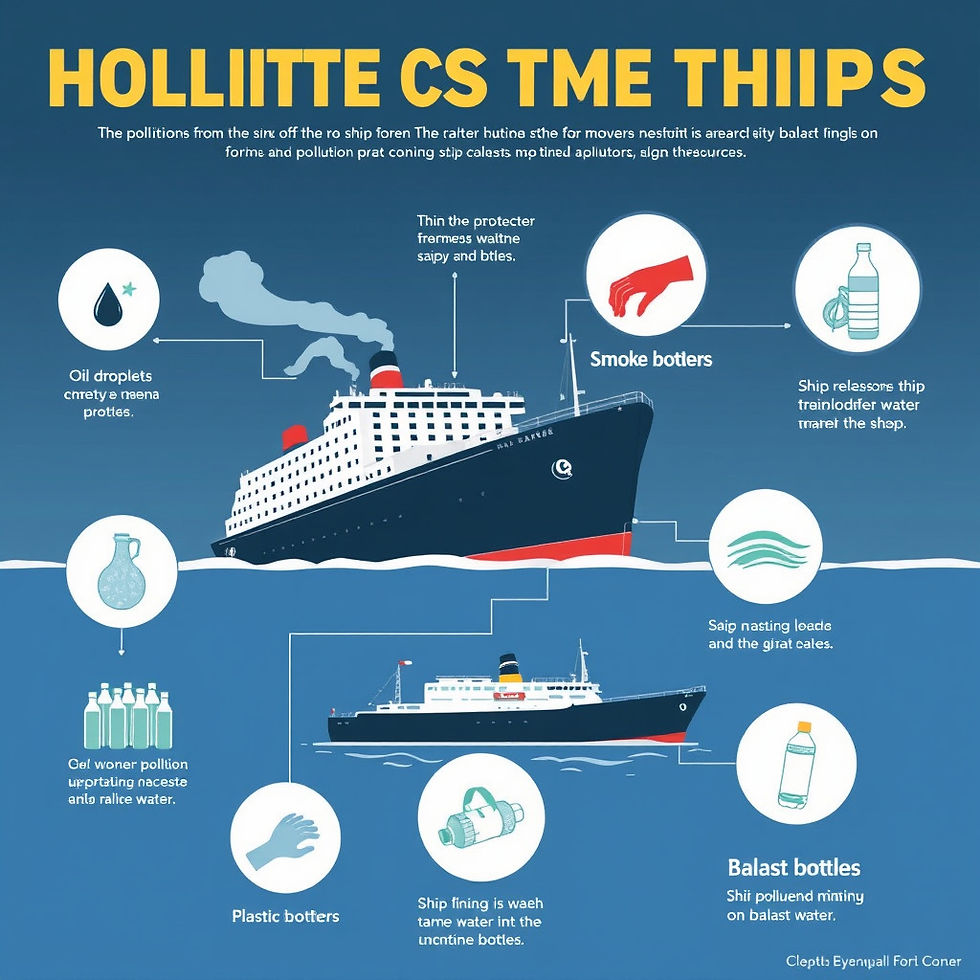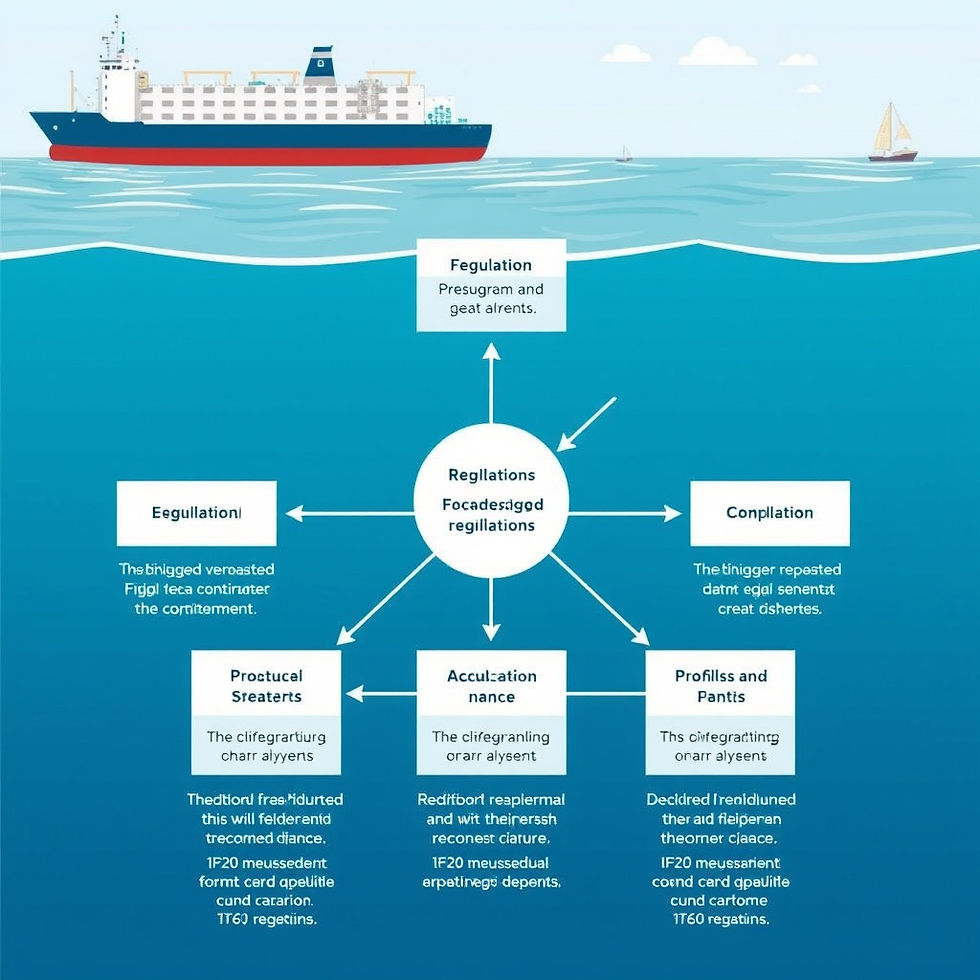Navigating Green Seas: Essential Environmental Regulations & MARPOL for Ships
- kousik pattanayak

- Jun 14
- 7 min read
Updated: Aug 4
Introduction:
The vast global ocean is the lifeblood of international trade, with the maritime industry facilitating nearly 90% of all global commerce. Yet, this vital sector carries a profound responsibility towards our planet. Pollution from ships poses significant environmental challenges, threatening delicate marine ecosystems, exacerbating climate change, and directly impacting coastal communities worldwide. To mitigate these pervasive issues, a robust framework of international regulations has been established, with MARPOL (International Convention for the Prevention of Pollution from Ships) standing as the cornerstone of ship pollution control.
In this comprehensive blog post, we will delve deep into:
The key environmental regulations for ships that govern responsible maritime operations.
The MARPOL basics, exploring its foundational structure and the vital role of its six annexes.
Essential best practices for pollution control onboard, ensuring a sustainable future for shipping.
Why Pollution Control on Ships is Absolutely Essential
Without stringent IMO regulations and diligent compliance, the environmental footprint of global shipping would be catastrophic. The sheer volume of vessels traversing our oceans means that even small, frequent acts of pollution accumulate into massive environmental damage. Ships can contribute to:
Oil Spills: Perhaps the most visually devastating form of marine pollution, oil spills wreak havoc on marine life, destroy coastlines, and cripple coastal economies for decades. From major tanker accidents to smaller operational discharges, oil directly smothers wildlife and contaminates habitats.
Air Pollution: Emissions from ship engines contribute significantly to global air pollution. Specifically, sulfur oxides (SOx) and nitrogen oxides (NOx) lead to acid rain, respiratory illnesses in coastal populations, and contribute to smog formation. Greenhouse gas emissions from ships also play a role in accelerating climate change.
Plastic & Garbage Waste: The scourge of plastic pollution is well-documented. Ships, if not properly managed, can discharge vast quantities of plastic and other garbage into the oceans, contaminating pristine waters, entangling marine species, and disrupting marine food chains.
Ballast Water Pollution: An often-overlooked but equally severe threat, ballast water taken on in one port and discharged in another can introduce invasive species into new ecosystems. These non-native organisms can outcompete local species, disrupt food webs, and cause irreversible ecological and economic damage.
🎯 Strict environmental regulations are not just bureaucratic hurdles; they are indispensable safeguards for ensuring sustainable shipping practices and protecting our fragile planet!

Key Environmental Regulations for Ships: A Global Framework:
The maritime industry operates under a complex web of international treaties and regional regulations designed to minimize its environmental impact. Here are some of the most critical:
MARPOL 73/78 (International Convention for the Prevention of Pollution from Ships):
Established by: The International Maritime Organization (IMO), a specialized agency of the United Nations responsible for the safety and security of shipping and the prevention of marine and atmospheric pollution by ships.
Scope: MARPOL is the main international convention covering prevention of pollution of the marine environment by ships from operational or accidental causes. It comprehensively addresses pollution by oil, noxious liquid substances in bulk, harmful substances carried in packaged form, sewage, garbage, and air pollution from ships.
Reach: Its global applicability extends to approximately 99% of the world’s merchant fleet, making it universally recognized as the primary legal instrument for pollution prevention at sea.
Ballast Water Management (BWM) Convention:
Purpose: Directly targets the menace of invasive species. This convention mandates that ships manage their ballast water to prevent the spread of aquatic organisms and pathogens from one region to another.
Requirement: Requires ships to install ballast water treatment systems onboard to purify the water before discharging it, neutralizing or removing harmful organisms.
SOLAS (Safety of Life at Sea) Regulations:
Focus: While primarily focused on safety, SOLAS plays an indirect but vital role in ship pollution control. By ensuring the safe design, construction, equipment, and operation of ships, it significantly reduces the likelihood of accidents that could lead to environmental hazards, such as collisions resulting in oil or chemical spills, or fires causing air pollution. It includes provisions for fire prevention, emergency response procedures, and robust vessel integrity.
EU MRV & IMO DCS (Carbon Emission Regulations):
Goal: These regulations are at the forefront of tackling climate change within the shipping sector.
EU MRV (Monitoring, Reporting, Verification): A European Union regulation that mandates the monitoring, reporting, and verification of CO₂ emissions from ships calling at EU ports.
IMO DCS (Data Collection System): The IMO's global system for collecting fuel consumption data from ships.
Impact: Both systems encourage ship owners and operators to improve energy efficiency and invest in greener ship designs and operational practices to reduce their greenhouse gas footprint.

MARPOL Basics – The Six Annexes: Your Guide to Pollution Prevention
The strength of MARPOL compliance lies in its systematic approach, divided into six distinct annexes, each dedicated to a specific type of marine pollution. Ships must comply with the provisions of the annexes that apply to their operations.
Annex | Pollution Type | Key Regulations & Impact |
Annex I | Oil Pollution | The most fundamental and oldest annex. It prevents oil spills by regulating the discharge of oil and oily mixtures. It mandates the use of oil filtering equipment (e.g., Oil Content Meters, Oily Water Separators) and requires ships to have an Oil Record Book to document all oil transfers and discharges. It also specifies requirements for sludge tanks and discharge connections. |
Annex II | Noxious Liquid Substances (NLS) | Regulates the discharge of harmful chemicals carried in bulk, such as chemicals in chemical tankers. It categorizes substances by their danger and sets strict limits and conditions for their discharge. Ships carrying NLS must have a Cargo Record Book. |
Annex III | Harmful Substances in Packaged Form | Ensures the safe transport and disposal of harmful substances carried in packaged form (e.g., containers, portable tanks, freight containers). Requires proper packaging, labeling, documentation, stowage, and quantity limitations to prevent accidental release. |
Annex IV | Sewage Pollution | Aims to control pollution from sewage. Requires ships above a certain size (or carrying a certain number of persons) to either have sewage treatment plants onboard or to discharge sewage only when more than 3 nautical miles from land (for comminuted and disinfected sewage) or more than 12 nautical miles from land (for untreated sewage). |
Annex V | Garbage Pollution | Critically addresses marine litter. It imposes a total ban on the dumping of plastics into the sea. It also regulates the disposal of various types of garbage (e.g., food waste, paper, glass, metal) based on distance from land and special areas. Ships must carry a Garbage Management Plan and Garbage Record Book. |
Annex VI | Air Pollution | Focuses on preventing air pollution from ship exhausts. It limits sulfur oxides (SOx) emissions (e.g., IMO 2020 low sulfur cap), nitrogen oxides (NOx) emissions (through engine technology requirements), and ozone-depleting substances. It also addresses greenhouse gas emissions (like CO₂) through measures like the Energy Efficiency Design Index (EEDI) and Ship Energy Efficiency Management Plan (SEEMP). |
🎯 Ships must comply diligently with all applicable MARPOL regulations to prevent environmental damage and ensure responsible operations!

Best Practices for Pollution Control On Ships: Operational Excellence
Beyond regulatory compliance, adopting best operational practices is vital for proactive ship pollution control and demonstrating environmental stewardship. Every seafarer plays a crucial role in minimizing the ship's ecological footprint:
Use Low-Sulfur Fuels: Adhering to the IMO 2020 standards and using fuels with a maximum sulfur content of 0.50% (or 0.10% in Emission Control Areas - ECAs) drastically reduces harmful SOx emissions, improving air quality globally.
Install Ballast Water Treatment Systems (BWTS): Modern ships are increasingly equipped with advanced BWTS that use various methods (e.g., UV, filtration, chemical) to neutralize harmful organisms in ballast water before discharge, preventing the spread of invasive species.
Implement Robust Waste Management Plans: Develop and strictly follow a ship-specific Garbage Management Plan and Sewage Management Plan. This includes proper segregation, storage, processing (compaction, incineration where allowed), and disposal of all waste at approved shore reception facilities. Never dump prohibited waste at sea.
Conduct Regular Maintenance & Inspections: Proactive and diligent maintenance of machinery, piping, and equipment (especially in the engine room) is critical. This prevents oil leaks, chemical spills, and equipment failures that could lead to accidental pollution. Regular inspections help identify and fix potential issues before they become environmental hazards.
Train Crew on Environmental Compliance: Comprehensive and ongoing environmental compliance training for all crew members is paramount. This ensures every individual understands their responsibilities, knows the ship's specific procedures, and is aware of the consequences of non-compliance. Regular drills reinforce responsible operations and emergency response for pollution incidents.
Optimize Vessel Performance: Implementing energy-efficient ship designs and operational practices (e.g., optimized routing, slow steaming, hull cleaning) not only reduces fuel consumption but also significantly lowers greenhouse gas and air pollutant emissions.

Conclusion:
Environmental regulations, most notably the MARPOL Convention, are indispensable pillars of responsible global shipping. They provide a vital framework that guides the maritime industry towards minimizing its impact on our precious oceans and atmosphere. By adhering to strict MARPOL compliance, implementing comprehensive ship pollution control measures, and embracing proactive best practices, the maritime sector can significantly reduce its environmental footprint and ensure a sustainable future for global trade.
Every seafarer, every shipping company, and every regulatory body has a role to play in navigating towards greener seas. The health of our planet depends on it.
🚢 What are your thoughts on pollution control in the maritime industry? What challenges have you observed, or what innovative solutions do you think are most effective? Share your insights and experiences in the comments below!
📢 If you found this guide informative and helpful, please give it a thumbs up, share it with your colleagues, and subscribe for more essential maritime safety updates, career insights, and environmental awareness content!
Comments